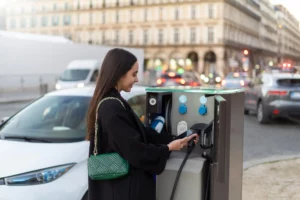
Home / EV Charging News / Does Level 2 Charging Harm the Battery?
As electric vehicles (EVs) become a common sight on our roads, EV owners are increasingly focused on maintaining their vehicles’ longevity and performance. One question that often arises is whether using a 240-volt charger can harm the battery. To answer this question, we need to delve into the details of this charging method and its effects on battery health.
Level 2 charging refers to the use of a 240-volt power source, similar to the electrical outlets used for large home appliances like dryers and ovens. This method is significantly faster than using a standard 120-volt household outlet, known as Level 1. A 240-volt charger can provide between 10 to 60 miles of range per hour, depending on the power output and the vehicle’s capacity. These chargers are commonly installed in homes, workplaces, and public stations, offering a balance between speed and convenience.
Using a 240-volt charger offers several benefits that make it an attractive option for many EV owners. Firstly, the increased speed means that EVs can be recharged more quickly compared to using a 120-volt outlet, reducing downtime and making it more convenient for daily use. This is particularly useful for those who drive their EVs frequently or have longer commutes. Additionally, 240-volt chargers are more efficient and can fully charge an EV overnight, making them ideal for home installation.
Another advantage is that this charging method can support better battery management. Most modern EVs are equipped with battery management systems (BMS) that regulate the process, ensuring that the battery is charged optimally. This includes managing the rate to prevent overheating and balancing the charge across all battery cells to maintain their health.
While using a 240-volt charger offers many benefits, some concerns have been raised about its potential impact on battery health. One of the main issues is that faster charging generates more heat, which can contribute to battery degradation over time. Heat is a known factor that accelerates the aging process of lithium-ion batteries, leading to reduced capacity and efficiency.
However, it’s important to note that modern EVs are designed with advanced thermal management systems that mitigate the effects of heat. These systems actively cool the battery during the process, ensuring that the temperature remains within a safe range. As a result, the risk of heat-induced damage is significantly reduced.
Another concern is the impact of frequent charging cycles on battery longevity. Charging the battery more often, even at higher speeds, can theoretically reduce its lifespan due to the increased number of charge and discharge cycles. However, this effect is generally more pronounced with DC fast charging, which delivers even higher power levels and generates more heat. Using a 240-volt charger, being less intense than DC fast charging, poses a lower risk in this regard.
To better understand the impact of using a 240-volt charger, it’s useful to compare it to other methods. Level 1 charging, as mentioned earlier, is slower and less efficient but generates minimal heat, making it gentler on the battery. However, the slow rate can be impractical for many users, especially those who need to recharge their vehicles quickly.
DC fast charging provides the fastest times by delivering direct current (DC) power directly to the battery. While convenient for long-distance travel and emergencies, frequent use of DC fast charging can accelerate battery degradation due to the high heat and stress involved.
In comparison, a 240-volt charger strikes a balance between speed and battery health, making it a practical choice for regular use. It offers a reasonable time without the excessive heat generation associated with DC fast charging, while still being faster and more convenient than a 120-volt outlet.
Most EV manufacturers recommend a combination of using a 240-volt charger and a 120-volt outlet for optimal battery health. They advise using a 240-volt charger for regular, daily needs and reserving DC fast charging for long trips or when a quick recharge is necessary. This balanced approach helps maintain battery health while providing the convenience of faster charging times when needed.
Manufacturers also suggest following best practices such as avoiding extreme states of charge—keeping the battery level between 20% and 80% for daily use—to further extend the battery’s lifespan. Additionally, using the vehicle’s built-in timers and charging features to schedule during off-peak hours can help manage the thermal load and reduce electricity costs.
In conclusion, using a 240-volt charger does not inherently harm EV batteries when used appropriately. While it generates more heat than a 120-volt outlet, modern EVs are equipped with sophisticated thermal management systems that mitigate these effects. By following manufacturer recommendations and best practices, EV owners can use a 240-volt charger as a convenient and efficient way to keep their vehicles powered without significantly impacting battery health. As with any technology, balanced usage is key to maximizing longevity and performance.
